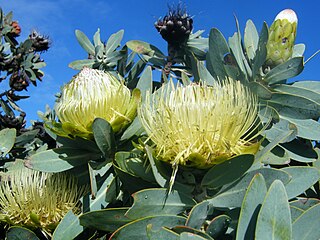
The kola nut is the seed of certain species of plant of the genus Cola, placed formerly in the cocoa family Sterculiaceae and now usually subsumed in the mallow family Malvaceae. These cola species are trees native to the tropical rainforests of Africa. Their caffeine-containing seeds are about 5 centimetres (2.0 in) across and are used as flavoring ingredients in various carbonated soft drinks, from which the name cola originates.

Baphia nitida, also known as camwood, barwood, and African sandalwood, is a shrubby, leguminous, hard-wooded tree from central west Africa. It is a small understorey, evergreen tree, often planted in villages, and known as osun in Yoruba.

Protosphyraena is a fossil genus of swordfish-like marine fish, that thrived worldwide during the Cretaceous period (Albian-Maastrichtian). Fossil remains of this taxon are mainly discovered in North America and Europe, and potential specimens are also known from Asia, Africa and Australia. Its fossils are best known from the Smoky Hill Member of the Niobrara Chalk Formation of Kansas.
Neomacounia nitida, or Macoun's shining moss, is an extinct moss that was found only in a small area of Ontario, and the sole species in the genus Neomacounia.

Segmentina nitida, the shining ram's-horn snail, is a species of minute, air-breathing, freshwater snail, an aquatic gastropod mollusc or micromollusc in the family Planorbidae, the ramshorn snails.

Nothofagus nitida is an evergreen tree, native to southern Chile and Argentina. It is found from latitude 40° S to Última Esperanza.

Akuammine (vincamajoridine) is an indole alkaloid. It is the most abundant alkaloid found in the seeds from the tree Picralima nitida, commonly known as akuamma, comprising 0.56% of the dried powder. It has also been isolated from Vinca major. Akuammine is structurally related to yohimbine, mitragynine and more distantly Voacangine, all of which are alkaloid plant products with pharmacological properties.

Pericine is one of a number of indole alkaloids found in the tree Picralima nitida, commonly known as akuamma. As with some other alkaloids from this plant such as akuammine, pericine has been shown to bind to mu opioid receptors in vitro, and has an IC50 of 0.6 μmol, within the range of a weak analgesic. It may also have convulsant effects.
Nitida, Nitidum and Nitidus are forms of the Latin for "bright, shining, sleek, blooming, smart" and may refer to:
Nitida saga or Nítíða saga is a fictional late medieval Icelandic romance saga thought to have been composed in Iceland in the fourteenth century. This saga is about a maiden-king named Nitida, who rules over France, and who is pursued by kings and princes from such faraway places as Constantinople, India, and a place the saga calls the Land of the Saracens. It is thought to be a direct response to Klári saga: in Klári saga, the main female protagonist, Serena, is brutally punished for her initial refusal to marry the hero Klárus, whereas the heroine of Nitida saga is portrayed much more favourably. Ethnicity, travel, and geography play important roles in the saga, and questions of gender and power, while magic, trickery, and deception are also prominent.

Lonicera nitida is a species of flowering plant in the honeysuckle family. In English, it is sometimes given the common names box honeysuckle or Wilson's honeysuckle. It is widely used as a low hedging plant, and for topiary. It is also a popular low-maintenance ground cover plant for urban landscaping.

Eucalyptus nitida, commonly known as the Smithton peppermint, is a species of tree or mallee that is endemic to Tasmania. It has varying amounts of loose, fibrous or flaky bark, lance-shaped to curved adult leaves, flower buds in groups of nine to fifteen, white flowers and cup-shaped to hemispherical fruit.

Agrochola nitida is a moth of the family Noctuidae. It is found in most of Europe, except Great Britain, Ireland, and the Iberian Peninsula.

Passiflora nitida, the bell apple, is a tasty, but relatively unknown passion fruit. It is similar to P. laurifolia, with orange-yellow fruits that have a sweet, succulent pulp. It is a fast-growing tropical vine. Its flowers are blue and red, a bit like P. laurifolia and P. quadrangularis. The fruits grow up to 4 centimetres (1.6 in). The exact hardiness in unknown, but it is tropical and should be protected from prolonged temperatures below 50–55 °Passiflora nitida is the cousin of almost all the Passiflora species like P. actinia, P. flavicarpa, P. loefgrenii and so on. Its propagation is by seeds. The fruits are eaten fresh and reportedly quite good in flavor. The bell apple is a native to the Amazon jungle region. Passiflora nitida is also a useful fruit in a drink called Purple Passion. Passiflora nitida has one of the widest geographic ranges. It grows in the tropical lowlands from Costa Rica in the north and French Guiana in the northeast, through wide parts of Brazil.

Protea nitida, commonly called wagon tree, waboom or blousuikerbos, is a large, slow-growing Protea endemic to South Africa. It is one of the few Protea species that grows into trees, and the only one that has usable timber.

Cenarrhenes is a monytypic genus in the family Proteaceae containing the single species Cenarrhenes nitida, known as the Port Arthur plum or native plum. Cenarrhenes nitida is an evergreen shrub to small tree endemic to the rainforests and scrublands of western Tasmania. It bears white flowers in late spring followed by the development of fleshy fruit.

Picralima is a plant genus in the family Apocynaceae, first described as a genus in 1896. It contains only one known species, Picralima nitida, native to tropical Africa.

Akuammicine is a monoterpene indole alkaloid of the Vinca sub-group. It is found in the Apocynaceae family of plants including Picralima nitida, Vinca minor and the Aspidosperma.

The wych elm cultivar Ulmus glabra 'Nitida' [:'shining', an allusion to the smooth upper surface of the leaves], the smooth glossy-leaved wych, was described by Fries from specimens collected by P. C. Afzelius in 1841 on the island of Stora Karlsö, Sweden, as Ulmus montana nitida, in Novitiae Florae Suecicae: continuatio, sistens Mantissam III: 20 (1842). The Novitiae Florae Gotlandicae (1844) confirmed U. montana f. nitidaFr. as present on the islands of Stora Karlsö and neighbouring Lilla Karlsö off Gotland, Sweden, but did not report it from Gotland proper. A Stora Karlsö specimen from the Herbarium E. Fries is preserved in the Botanical Museum of Uppsala. The tree was listed by Rehder as U. glabraHuds. f. nitida (1915), a designation adopted by Krüssmann (1984), the latter copying Rehder's 'Norway' provenance error.

Callerya nitida is a species of flowering plant in the family Fabaceae, native to south-central and southeast mainland China, Hainan and Taiwan. It was first described by George Bentham in 1842 as Millettia nitida.
















